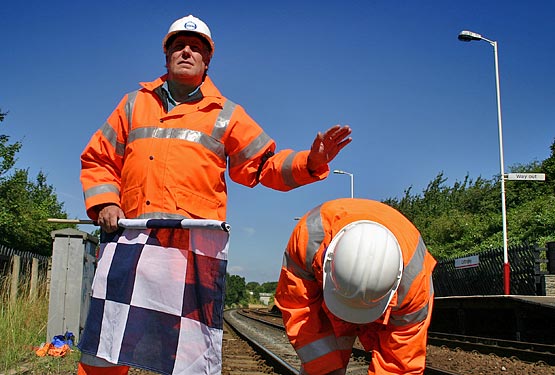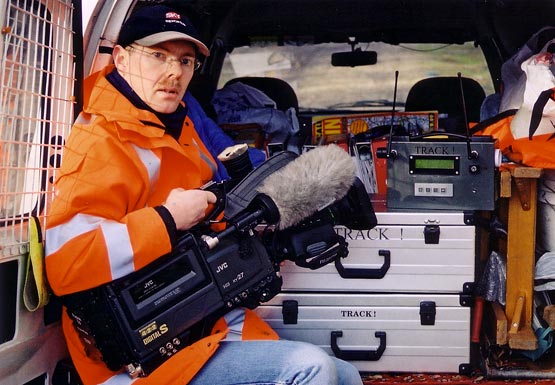|
A senior member of a contractor’s management team once expressed to me his wish to see red zone working totally eliminated. Whilst he recognised that there was little immediate prospect of this happening, he had convinced himself that the green-tinted safe havens defined in Rule Book Module T7 held the potential to rid the industry of workforce deaths and injuries. And that, after all, is something we would all welcome.
This was pre-Rimini, when green zones were first choice in theory only. Most deemed red to be the only practical option for the day-to-day business of maintenance men - an elephant in the room which safety professionals turned their backs on. Trouble was, once Rimini established a decision-making audit trail, the beast woke up and trampled its architects under foot.
Today, red zone working makes it presence felt more than it ever has since colour-coding was invented in the Nineties - in many respects, it has become endemic. The green zone statistics offered through Rimini’s infancy were laughable and clearly the function of selective analysis. So does this reality demonstrate that the hierarchy principle is just a distraction and should Rimini be consigned to the annals of history?
 |
| What's the problem with lookout protection? |
Rimini forced the industry to focus more attention on the planning of safe systems, a need brought into sharp focus by the fatality at Desborough in August 2001 which resulted in part from the COSS not having the resources available to block both lines, as the work demanded. Trouble is, Rimini planning has often been carried out by staff with little practical on-track experience and, because of the volumes involved, its quality can be questionable. All too often, the prevailing tick-box risk-averse culture forces voluminous quantities of paperwork to be generated - produced because it has to be, not because it is demonstrably high-value. And the fact that many COSSs never see their Rimini packs until moments before its specified safe system is due to be implemented serves to negate the benefits of it - you might just as well leave the poor chap to sort things out for himself as had previously been the approach.
For some time now, Network Rail has been reviewing the efficacy of Rimini and intends to overhaul it during the autumn. If this is as successful as its safety-critical communications initiative and efforts to sort out both COSS briefings and the rule breaking, we have no cause for optimism that any of Rimini’s structural failings will be repaired. Those on track will only ever believe that management genuinely prioritises safety over commercial considerations when it demonstrates such through its actions. But we all know that getting jobs done with minimal disruption is the only thing that matters to some managers and supervisors - a pressure that is not lessened by recent redundancies. Tinkering with Rimini will do nothing the tackle these cultural issues.
And what about the hierarchy? In January 2004, A D Little published research into the root causes of red zone working, finding that those at greatest risk from being hit by a train were people walking to or from their site, lone workers and staff such as handsignallers who help to set up green zones. “From the perspective of improving track safety performance it is not sufficient to concentrate solely on reducing the amount of Red Zone working” it found. “The majority of safety losses…result from workplace injuries and not from train strikes.” An analysis of over 100 formal inquiry/investigation reports found that 53% of incidents were associated with green zone working, whilst red accounted for just 32%. Unsurprisingly, 15% of incidents resulted from no safe system at all being established.
The fact that creating a green zone generally involves other people, beyond the benefitting workgroup, going on or near the line - increasing the overall level of risk exposure associated with the protection - is beyond the grasp of most safety specialists. They also can’t comprehend the unmitigated nonsense of separated green zones where the workforce and passing trains are kept apart by crossed fingers.
|
| They also can’t comprehend the unmitigated nonsense of separated green zones where the workforce and passing trains are kept apart by crossed fingers. |
|
On the face of it, ATWSs go some way to removing the blight of human fallibility from work on open lines, whilst freeing up more members of the workgroup to get their hands dirty. It is of course worth making the point that lookouts very rarely miss ‘approaching trains’, particular since RSSB’s five-point definition of the term emerged! But the benefits of these devices are also dented by the broader requirements associated with their use.
The 2002/3 Annual Report of Railway Safety (now RSSB) made the claim that it had “purchased a set of Track02, an automatic track warning system (ATWS), for use by the company that produces track safety videos. These are now being produced with the enhanced protection offered by the ATWS.”
I run the company that produced those videos and the last thing that Track02 did was enhance our protection. Back then, Railway Safety was grossly overfunded and it was not adverse to flushing money down the toilet if it helped to secure the level of its following year’s funding. Despite my protestations that the equipment would never be switched on, more the £30k was invested and the two-flight-case kit duly arrived.
But it was switched on, many times. I had to go on a training course which involved setting the system up on a live railway. The train detection sensors were positioned either side of the worksite, involving long walks down the line and then attaching them to the rail under the gaze of a lookout. Subsequent mentoring and assessments involved similar exercises. And each installation had to be planned in advance, requiring a site visit protected by…you guessed it!
Through its depressing but characteristic ignorance of life beyond the office suite, Railway Safety’s senior management had driven me and my colleague to spend more time on the operational railway and engage in much more red zone working with lookouts than we would ever have done otherwise, exposing us to wholly unnecessary risk. The assertion made in its Annual Report was risible.
 |
| Only the manufacturer benefited from Railway Safety's acquisition of a Track02 system. |
All that glitters is not green. Everyone must surely be in favour of limiting the dangers to which the on-track community is exposed but this must be done with eyes wide open, not blinkered by naivety and institutional show-boating. It should also be rooted within the bounds of reasonable practicability as the law requires. Closing the railway down to assure workforce safety - not that one necessarily follows the other - is an approach which flies in the face of logic and would rightly not be tolerated by government or taxpayer.
And the safety guru who advocates that all track work - yes, that includes patrolling and other basic tasks - on main and secondary routes should be carried out in overnight white periods might like to explain how he proposes to maintain lines that are trafficked 24/7. There are some very well meaning people out there in the over-populated world of health ‘n’ safety, but too many of them are living with the fairies.
It’s about time that TOWS - or a 21st century equivalent - was developed for junctions where the risks are highest. Network Rail’s unwillingness to do this, whilst stuffing our money hand-over-fist into the pockets of its self-serving Directors, is something for which we should hold it in contempt. Simplified line blockages - again, much promised by those upstairs - also need to be realised. But those apart, I wish lookouts great longevity and death to the hierarchy. Strategists forcing trackworkers to adopt protection methods that are less robust than simpler alternatives is a harmful culture which should long since have had its day.
Story added 1st July 2010
|